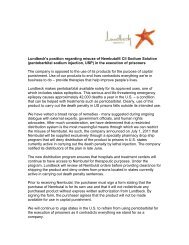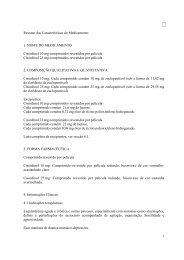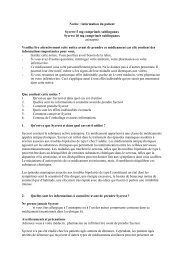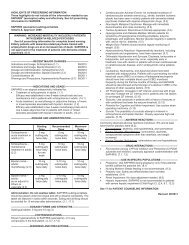Anxiety Disorders - Lundbeck
Anxiety Disorders - Lundbeck
Anxiety Disorders - Lundbeck
You also want an ePaper? Increase the reach of your titles
YUMPU automatically turns print PDFs into web optimized ePapers that Google loves.
<strong>Anxiety</strong> <strong>Disorders</strong><strong>Anxiety</strong> disorders are a common form of mental illness, often causing significantdistress and impairment, and leading to reduced quality of life.<strong>Anxiety</strong> overview<strong>Anxiety</strong> is a normal response to stress, worry or threat – but when it is very severe, long-lasting, or out ofproportion to the circumstances, it becomes known as an anxiety disorder.There are several different types of anxiety disorder: for example, generalised anxiety disorder, socialanxiety disorder, panic disorder and obsessive–compulsive disorder. By affecting a person’s mood,thoughts and behaviour, an anxiety disorder can make it difficult to cope with daily life at home, at work orschool, and when socialising.<strong>Anxiety</strong> disorders are caused by an imbalance of chemicals in the brain. The exact trigger for this changeis not known, although people who are exposed to certain biological and social conditions may have anincreased risk of developing anxiety disorders.SymptomsAlthough they vary between individuals, typical symptoms of anxiety disorders include fear, inner tension,irritability and poor concentration, and physical signs such as dry mouth, dizziness, tense muscles,sweating and palpitations – all of which interfere with daily life. A person may suffer from more than oneanxiety disorder at the same time, and sometimes alongside other mood disorders such as depression(so-called ‘co-morbidity’).Generalised anxiety disorder (GAD) involves a non-specific anxiety that something undesirable couldhappen. Excessive and uncontrollable worry, anxiety and tension are typical symptoms, together withphysical symptoms such as dry mouth, clammy hands, sweating or dizziness.Social anxiety disorder (SAD) causes people to fear or avoid social situations. The person fears that he orshe will act in a way that will be humiliating or embarrassing.Panic disorder is typified by sudden panic attacks associated with marked fear or nervousness. Panicdisorder can also include physical symptoms such as sweating, pain, headache, nausea, a poundingheart or a dry mouth.Obsessive–compulsive disorder (OCD) causes repetitive, obtrusive and unwanted thoughts, which resultin unreasonable fears (obsessions) associated with cleanliness, body secretions or health, for example.In response to these fears, patients may also carry out special rituals (compulsions), including persistentwashing, cleaning, bathing, constant checking and rechecking, or maintaining a rigid diet.StatisticsIt has been estimated that anxiety disorders affect between 5 and 7% of the general population, and thatup to 29% of people will suffer from an anxiety disorder at least once during their lifetime. 1 In 2004, over28 million people worldwide had obsessive–compulsive disorder, and over 30 million experienced panicdisorder. 2
<strong>Anxiety</strong> disorders affect both men and women across the world, but the burden of the disease is greaterin women than in men. 3Seeking diagnosis and careMany treatments are available to effectively manage anxiety disorders, and personal support from familyand friends is valuable at all stages.During a medical appointment, a doctor will diagnose anxiety disorders by asking questions aboutsymptoms, daily life and family history. There may also be a physical examination to exclude otherconditions. If an anxiety disorder is confirmed, treatment options will then be considered, includingmedications, counselling, social support, exercise, relaxation and self-help techniques.In all cases, it is important that professional advice is sought.Sources1. Baldwin, D.S. and Hirschfeld, R. M. A. (2005).Fast Facts: Depression, 2nd edn. Health Press,Oxford,UK.2. World Health Organization (2004). Prevalence for Selected Causes in WHO Regions, 2004.http://www.who.int/healthinfo/global_burden_disease/PREV6%202004.xls. Accessed 16/09/11.3. World Health Organization (2004). The Global Burden of Disease. 2004 Update.www.who.int/healthinfo/global_burden_disease/2004_report_update/en/index.html. Accessed 16/09/11.


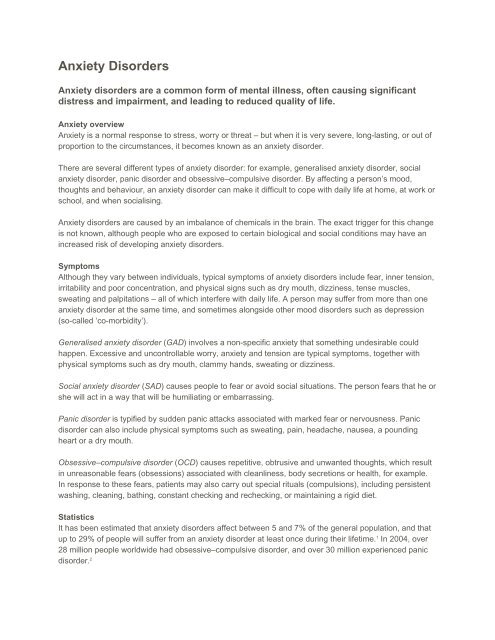



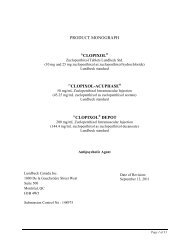
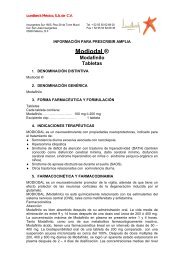

![[Product Monograph Template - Standard] - Lundbeck](https://img.yumpu.com/49015733/1/190x245/product-monograph-template-standard-lundbeck.jpg?quality=85)


